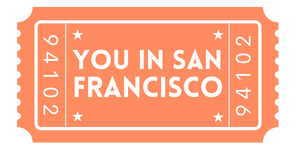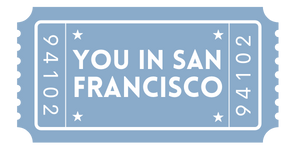. . . MOVING AROUND SAN FRANCISCO . . .
This was meant to be a brief overview of the transportation systems around SF, but it's hard to put 15 years of navigating the city into a short guide. There are lots of additional links to learn from.
• • • MUNI • • •
Muni, San Francisco Municipal Railway, is the public transit system for SF. These include buses, railroad system and cable car.
MUNI FARE
One Muni ticket lasts for 120 minutes, meaning if your trip requires you to change buses or trains you don't need to repurchase a ticket if it's within the 120 minute limit (which it usually is). Anyone under 19 rides free! Additional fare info here.
• MuniMobile: The app makes it easy to purchase tickets through your phone. One incentive for MuniMobile is that it has an unlimited $5 a day pass, discounted ticket prices compared to using cash and reduced prices for Visitor Passports.
• Cash: You can directly pay cash on the bus or train at the front of the vehicle, make sure to have exact fare since no change is given back. For underground trains, you can purchase tickets at the ticket machines (they take both cash and card).
• Clipper: Clipper is the Bay Area's all-in-one transit card that works on 24+ transport services around the bay. Most notable ones being; Muni, BART, Caltrain, SF Bay Ferry and more. You can use the Clipper app, get a clipper card in person, or you can directly add the Clipper card to your Apply pay. How to here. The advantageous thing about Clipper is that you can setup the card only once and use it on almost all major transport systems in SF making it easy to manage and less things to worry about.
• • • BART • • •
BART is the Bay Area Rapid Transit system. BART takes you to other cities around the bay such as Oakland, Berkeley, Richmond and more. It also goes to SF airport and Oakland airport.
BART FARE
Unlike Muni, BART fares are dependent on how mach distance the person has traveled, therefore you have to have to beep your Clipper (or phone) before you enter the station and as you exit the station. You can use the Fare Calculator to know exactly how much fare is going to cost between two stops. You can also preload a certain amount (ex. $20) and use it throughout your trip without worrying about calculating exact fare.
All stations have Clipper ticket purchasing machines where you can purchase a Clipper card.
The ticket cost from the two farthest apart BART stations in San Francisco (Balboa Park to Embarcadero) is $2.10 one way. So $20 goes a long way in my experience. However, taking the BART to another city tends to be between $3-$7 depending how far you travel.
• • • Bikeshare • • •
Bay Wheels has stations and bikes available all across San Francisco. You need to the app to operate the bikes. You can also link your Clipper card to unlock bikes. They have both electric and regular bikes. Lots of bike lanes across SF make it easy to bike around SF. Overview here
• • • Walk it! • • •
Since SF is a small city, 7x7 miles it is very walk-able. Walking is my favorite mode of transportation in the city, each neighborhood offers a diversity of culture and experience to enjoy. SF is filled with beautiful greenery, street-art and stunning architecture that is best enjoyed on walks throughout the diverse neighborhoods.
• • • Driving • • •
Some neighborhoods in SF are better accessible via car because the transportation runs a bit infrequently or limited options. Driving is quick, usually going from one side of SF to another takes about 25 minutes max or much less. However, since SF is a bustling city with an unlimited flow of buses, trains, pedestrians and cyclists, it requires tenacious attention to safely drive in SF. Here are some tips:
Parking tips:
1. NEVER LEAVE YOUR BELONGINGS IN THE CAR EVER (even if it's an empty bag or a jacket). Always put everything in the trunk or take it with you. It is no surprise that SF is known for it's car window break-ins so the best and most effective tip (from my experience) is to make sure you don't leave anything in your car.
2. Parking is tourist areas is very expensive, if you are confident in your parking abilities you can look for street parking in neighboring areas. Street parking, in residential streets is free just make sure you are not blocking anyone's driveway. Meter parking also tends to be a bit cheaper than parking garages.
3. Make sure to ALWAYS READ THE SIGNS that inform on the street cleaning or other parking limitations. More info about street parking here from the SFMTA website! Another excellent resource explaining SF Parking by SpotAngles a detailed overview.
4. Parking garages are a good option, although they can be a bit expensive but it is a safer options especially if you do not want to deal with reading the signs or driving around looking for parking.

